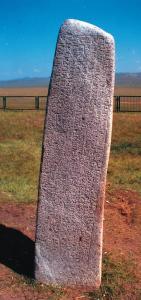The Turkic word bitig or bitik means «the letter, the text» (Радлов В.В. Опыт словаря тюркских наречий. Санкт-Петербург, 1911, том. IV, часть, 2, С. 1775-1778; Марғұлан Ә.Х. Қазақ жазуының тарихы // «Жұлдыз» журналы, Алматы, 1984. № 8, 203-205 б.; Марғұлан Ә.Х. Найман, Керей, Оңгiттердiң жазулары // «Жұлдыз» журналы, Алматы , 1991. 70-76 б. Академик Ә.Х. Марғұлан «түрiк бiтiк» деп жазған; Базылхан Б. Эртний түрэг бичээсний хэлний үгийн бүтэц (Көне түрік жазба тілінің сөз құрылысы) Улаанбаатар, 1984. 57 б. «biti-, bitir-, bitig (біту – to finish, бітіру – to finish, бітік - finished). The word bitig was formed of a root morpheme biti > biti - «to write». In modern Turkic languages there are forms «bitik, bitig, bijik, pichik, pytyq, butug, bidig», etc. The “Turk bitig” was the universal writing system for all Turkic ethnos of the time.
 |  |
| The Bilge kagan inscriptions. |
The Turk bitig is used in territory of present Mongolia, Altai, Tuva, Khakassia, Buryatiya, Turfan, Dunhuang, Miran, Kazakhstan, Fergana, Caucasus, Eastern Europe. The letters of Turk bitig are the general heritage of all modern Turkic ethnos.
After the Turk bitig the Turkic ethnos used old Uigur letters adapted for language of medieval Turkic ethnos. The Old Turkic letters had been superseded as a result of strong influence of Islam in territory of Central Asia. Any legend or tales of modern Turkic ethnos do not contain data about «the Turk bitig». There are words «bitik, bititti» in Mahmud Kasgari’s dictionary «Diuani-lugat it-turk» and comparison of 18 Uigur letters with the Arabian letters. Thus Turks still use the word bitik as letter in XI century (Divanü Lugat^t-Türk . Kasgarli Mahmud. Tipkibasim /Facsimile. Ankara , 1990. S.5).




















































































































